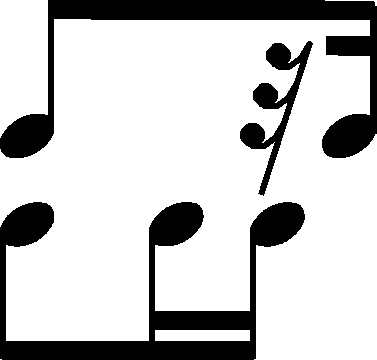



In the erroneous notation of the rhythm of the 1st crotchet in the bar –  – FE1 shares two elements with GE, i.e. the demisemiquaver rest and the alignment of the R.H. part with respect to the L.H. part (preserved in the above scheme). We can think of two possibilities – it is either an unfinished notation of the rhythm of GE or an unfinished correction of that rhythm, the possible aim of which was the rhythm introduced by FE1 and EE.
– FE1 shares two elements with GE, i.e. the demisemiquaver rest and the alignment of the R.H. part with respect to the L.H. part (preserved in the above scheme). We can think of two possibilities – it is either an unfinished notation of the rhythm of GE or an unfinished correction of that rhythm, the possible aim of which was the rhythm introduced by FE1 and EE.
The arguments for the first possibility are as follows:
- no traces of such a correction in FE – no traces of removal of the third beam and particularly no traces of removal of the dots prolonging the d
 2-d
2-d 3 octave; it is particularly the latter that are very difficult to remove completely. Examples of such traces can be seen in this bar in FE2 (remaining elements of a removed demisemiquaver rest), in b. 16 or 100 (remaining elements of removed noteheads). Moreover, there is not even space for a third beam – it could not have been possibly removed;
3 octave; it is particularly the latter that are very difficult to remove completely. Examples of such traces can be seen in this bar in FE2 (remaining elements of a removed demisemiquaver rest), in b. 16 or 100 (remaining elements of removed noteheads). Moreover, there is not even space for a third beam – it could not have been possibly removed; - in the version featuring a demisemiquaver the same note (f1) is not simultaneously played by two hands, which Chopin would generally avoid, e.g. in analog. b. 105 he omitted g
 1 notes in the semiquaver L.H. chords;
1 notes in the semiquaver L.H. chords; - the repeated L.H. semiquavers are accompanied by a rhythm with a demisemiquaver in this eight-bar section – cf. b. 28 and 32 – which is a kind of a characteristic feature of the first appearance of this thematic thought and which does not return anymore;
- some other rhythmic mistakes in FE1 – cf. b. 32 or 50.
The arguments for the second possibility:
- the rhythm of analog. phrases in b. 33, 55 and 59, 105 and 109, etc. However, neither of them includes the aforementioned situation in which both thumbs meet on one key;
- a possible similar correction of the rhythm in FE1 in b. 32. That correction is also highly unlikely, according to us – see the note on that bar.
According to us, it is the arguments supporting the first possibility that prevail, which means that the version of GE is most probably the only authentic rhythm of this place, which we thus give in the main text.
Compare the passage in the sources »
category imprint: Differences between sources
issues: Errors in FE, FE revisions
notation: Rhythm
